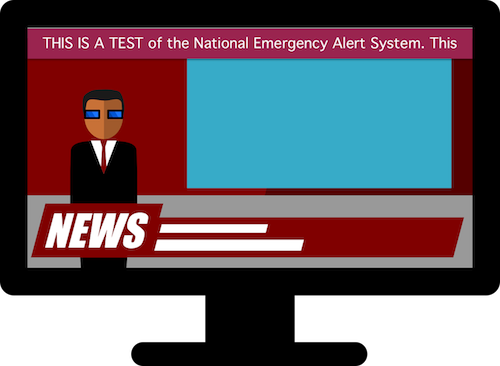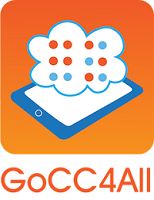Your help is important in making Emergency Alerts accessible to everyone

On August 11, the Federal Emergency Management Agency (FEMA) and the Federal Telecommunications Commission (FCC) will conduct a national test of emergency alerts. If you are deaf, blind, and/or have hearing or visual disabilities, your help will be very important to inform the FCC about accessibility problems in receiving these alerts.
During this test, the emergency alerts message will be sent via TV, radio, and cell phones.
TV and Radio Test
The text of the emergency alert message will be as follows: “THIS IS A TEST of the National Emergency Alert System. This system was developed by broadcast and cable operators in voluntary cooperation with the Federal Emergency Management Agency, the Federal Communications Commission, and local authorities to keep you informed in the event of an emergency. If this had been an actual emergency an official message would have followed the alert tone you heard at the beginning of this message. No action is required. "
If you usually receive emergency alerts through your TV, please check that they meet the following requirements.
1. If they are visual (video crawl or block text), the emergency alert message must be shown as follows:
- At the top of the TV screen or where it does not interfere with other visual messages such as closed captioning for the deaf;
- In a way that is easily readable and understandable. For example, that the text scrolls at a speed that allows the audience to read and understand the message, or that the colors of the text and the background have a sufficient contrast to allow for readability.
- It does not contain overlapping lines of text, nor does it extend beyond the visible screen (with the exception of video crawls that intentionally scroll on and off the screen);
- The alert message must be displayed in full at least once during the test.
2. As for the audible part of the emergency message, it must be played in its entirety at least once and must be read at a pace that allows the listener to understand the content. If the alert occurs during programming other than news, the alert must be repeated in its entirety at least twice using the secondary audio channel and must be preceded by an audible tone on that channel. The alert must take precedence over the programming on the secondary channel.
Cell Phones Test
The text of the emergency alert message will appear in English or Spanish, depending on the language setting of your phone. The text of the message in English will be as follows: “THIS IS A TEST of the National Wireless Emergency Alert System. No action is needed." The test message should arrive only once between 2:20 and 2:50 p.m. and it must be accompanied by a tone and a vibration.
You must have priorly enabled the reception of these types of messages on your cell phone. If you do not have them enabled, visit the article receiving emergency alert messages on your phone to know how to do it.
Share your opinion about the test
If you are deaf, blind, and/or have hearing or visual disabilities and you cannot clearly read or hear the emergency test messages, feel free to share your comments with the FCC using any of the following means:
- Online: www.fcc.gov/accessibilitycomplaints
- By phone: 1-888-225-5322 (voice); 1-844-432-2275 (video call for ASL users)
- Email: This email address is being protected from spambots. You need JavaScript enabled to view it.
- Postal Mail: Federal Communications Commission, Consumer and Governmental Affairs Bureau Disability Rights Office 45 L Street, NE Washington, DC 20554
These types of tests are very important to verify the operation and reliability of the national emergency alert system. Emergency information can be critical to saving lives. Your feedback on difficulties with accessing emergency information during the test is invaluable. No one is better than you to help evaluate the accessibility of this information!
 Finally, if you want to be informed in a timely manner about emergency alerts and always receive them in an accessible way, just use GoCC4All. This is an application developed by Dicapta Foundation with accessibility features specially designed for deafblind users. Download it for free from the App Store or the Google Play Store. You can find more information about GoCC4All visiting its website.
Finally, if you want to be informed in a timely manner about emergency alerts and always receive them in an accessible way, just use GoCC4All. This is an application developed by Dicapta Foundation with accessibility features specially designed for deafblind users. Download it for free from the App Store or the Google Play Store. You can find more information about GoCC4All visiting its website.
Sources:
“The Emergency Alert System (EAS).” FCC, actualizado Julio 21, 2021, https://www.fcc.gov/emergency-alert-system#block-menu-block-4
“Reminder regarding obligations to make televised emergency information accessible to viewers with disabilities.” FCC, Junio 30, 2021, https://docs.fcc.gov/public/attachments/DA-21-773A1.pdf
“Enforcement bureau reminds EAS participants of the obligation to ensure that emergency alerts are accessible to persons with disabilities.” FCC, Julio 21, 2021, https://docs.fcc.gov/public/attachments/DA-21-857A1.pdf
“FEMA and FCC Plan Nationwide Emergency Alert Test for Aug. 11.” FCC, Junio 11, 2021, https://docs.fcc.gov/public/attachments/DOC-373208A1.pdf
